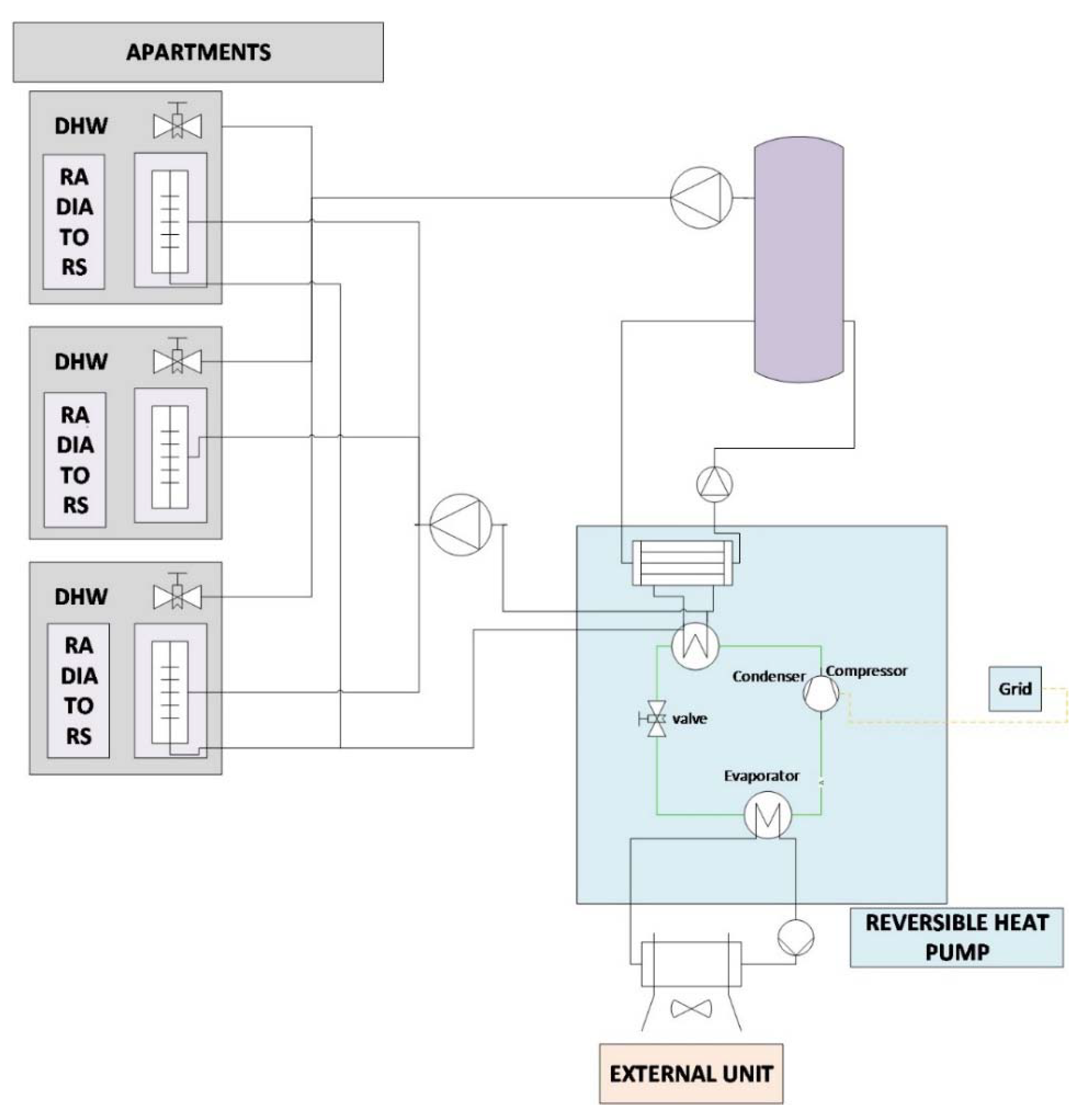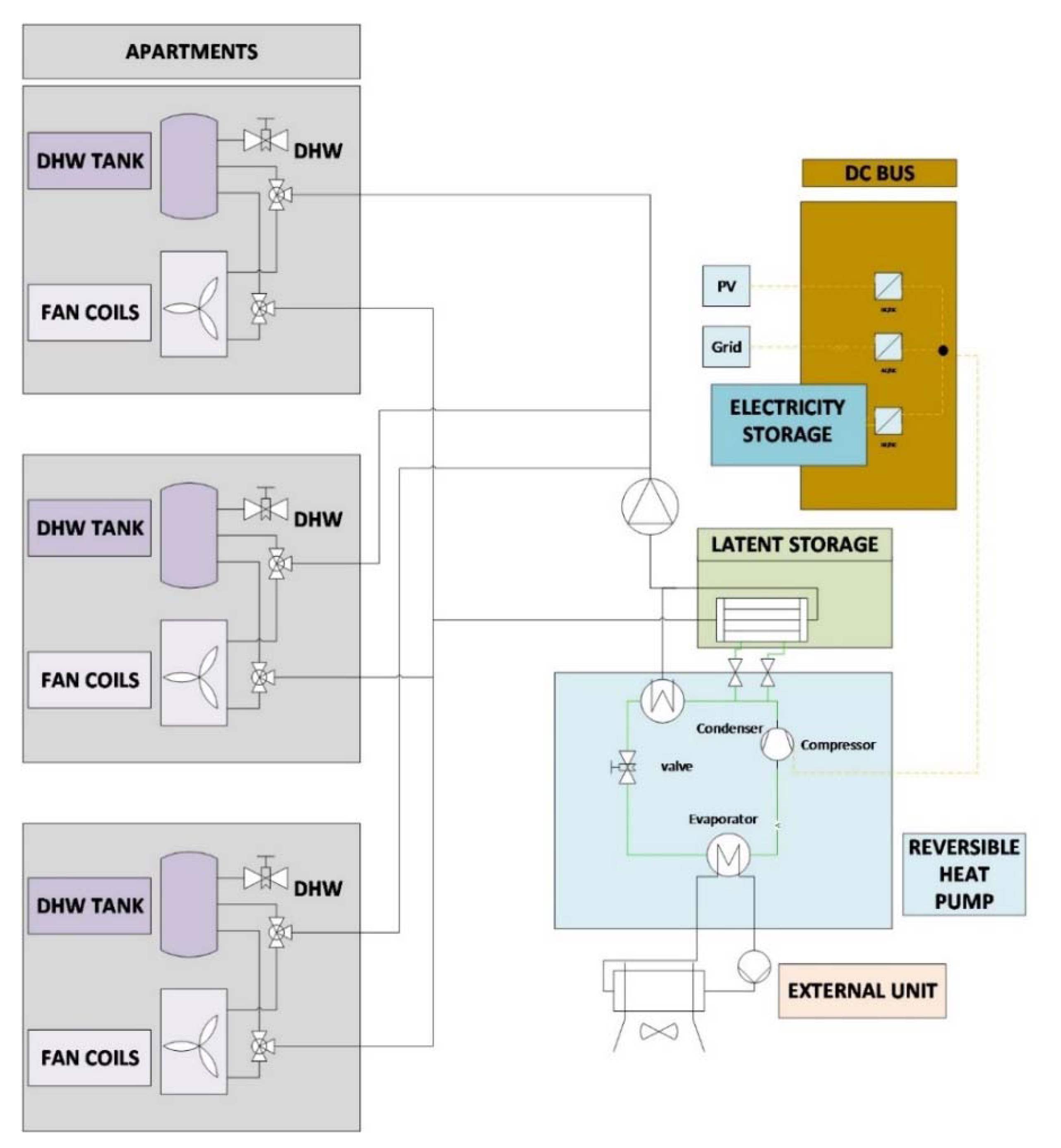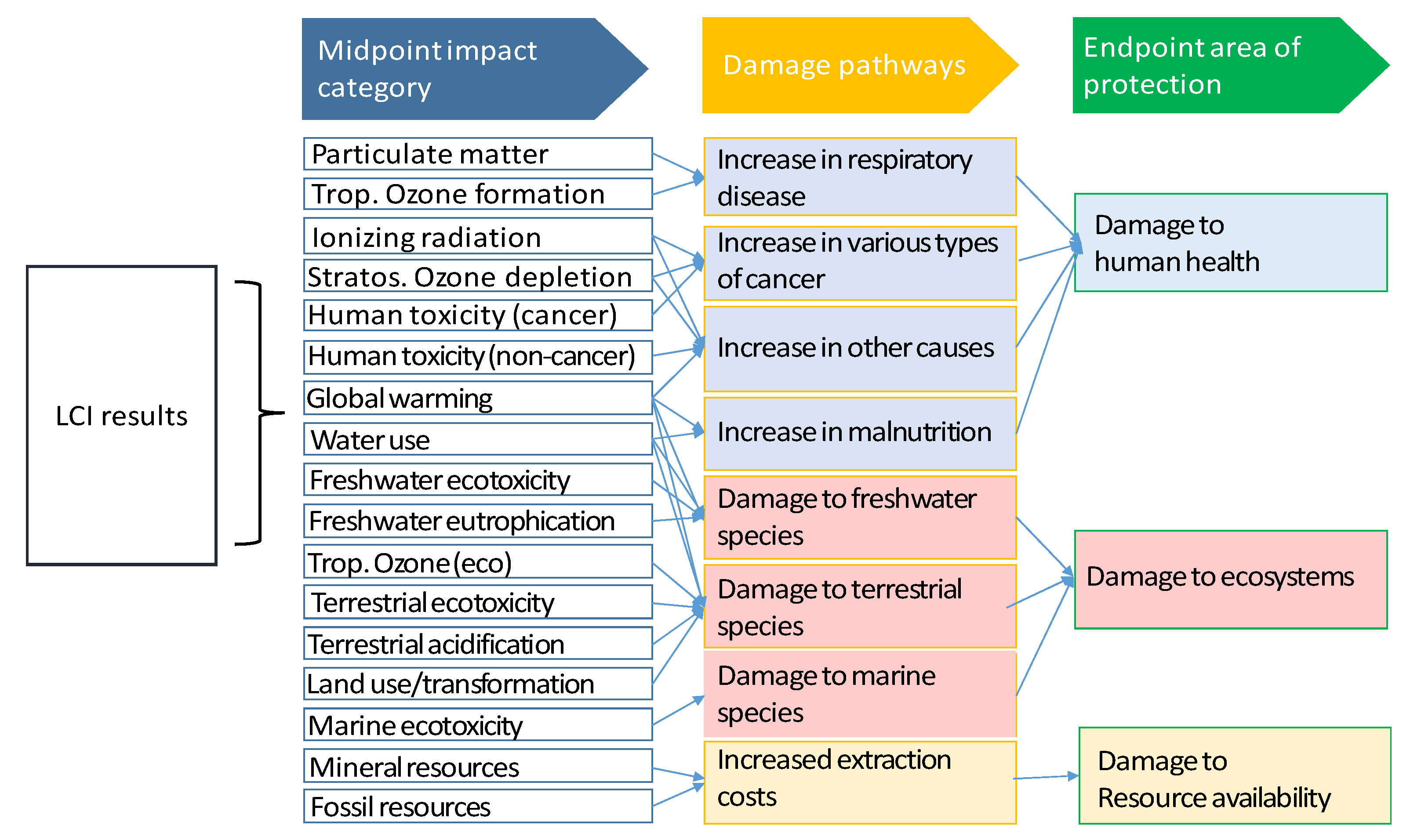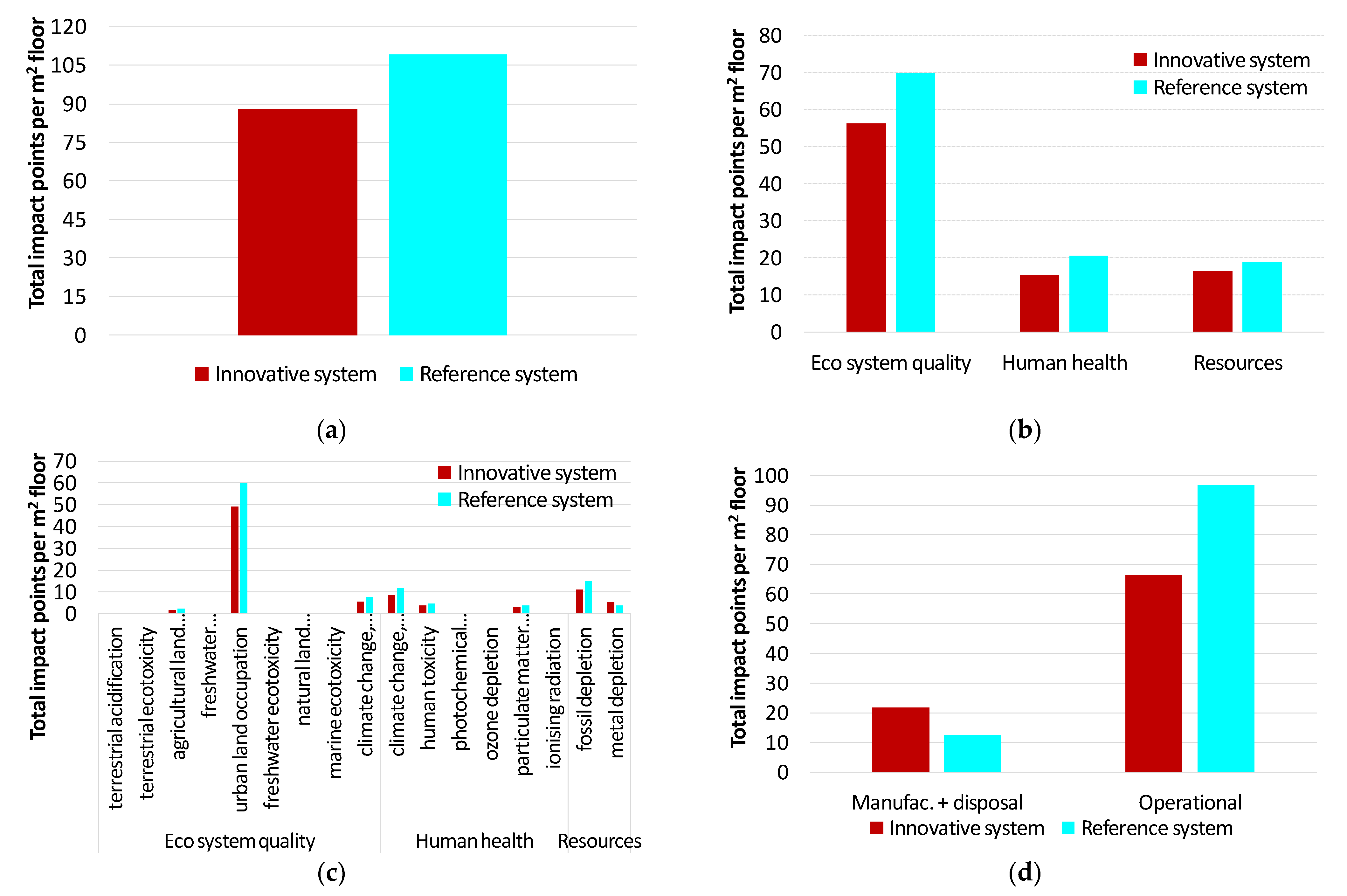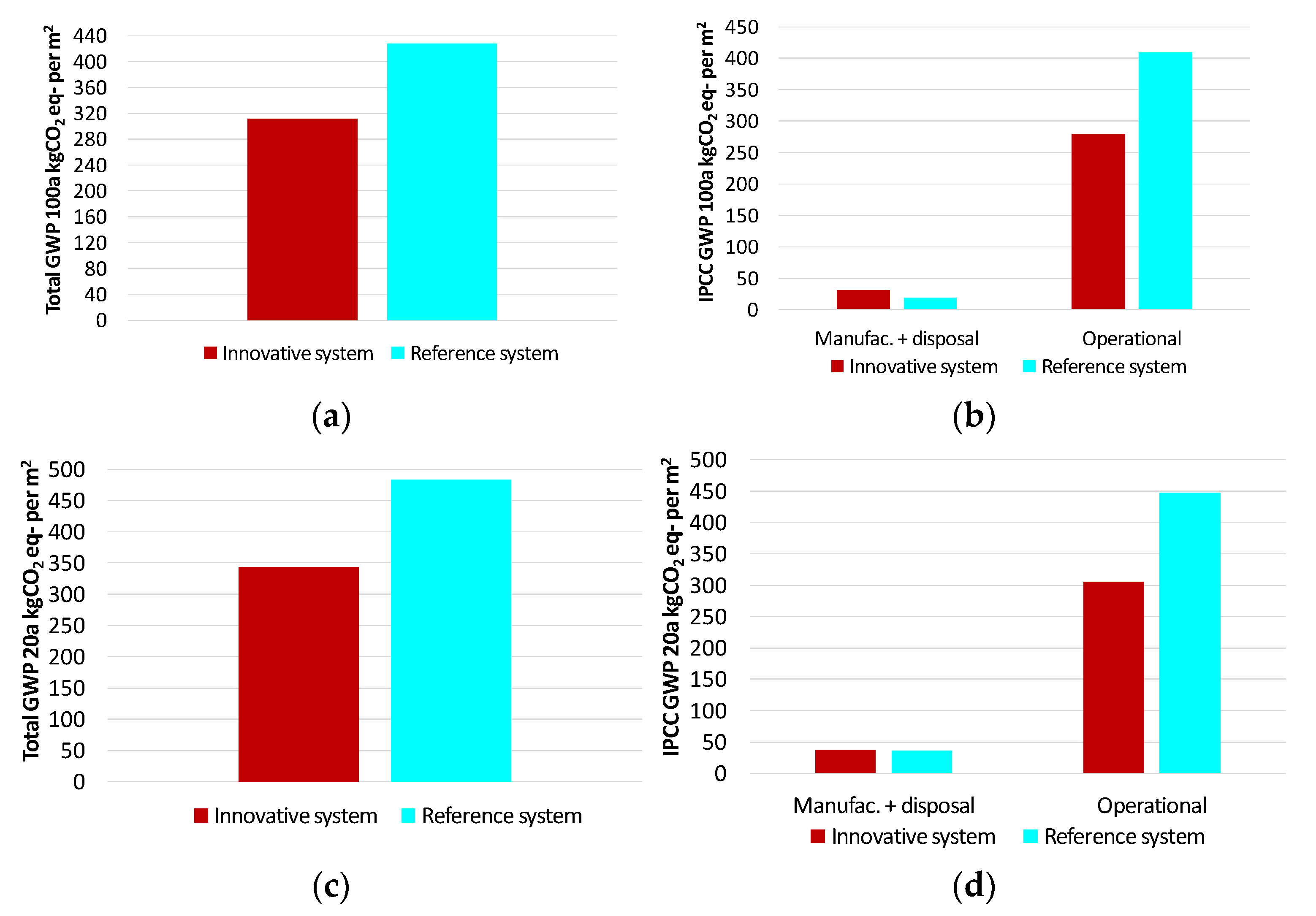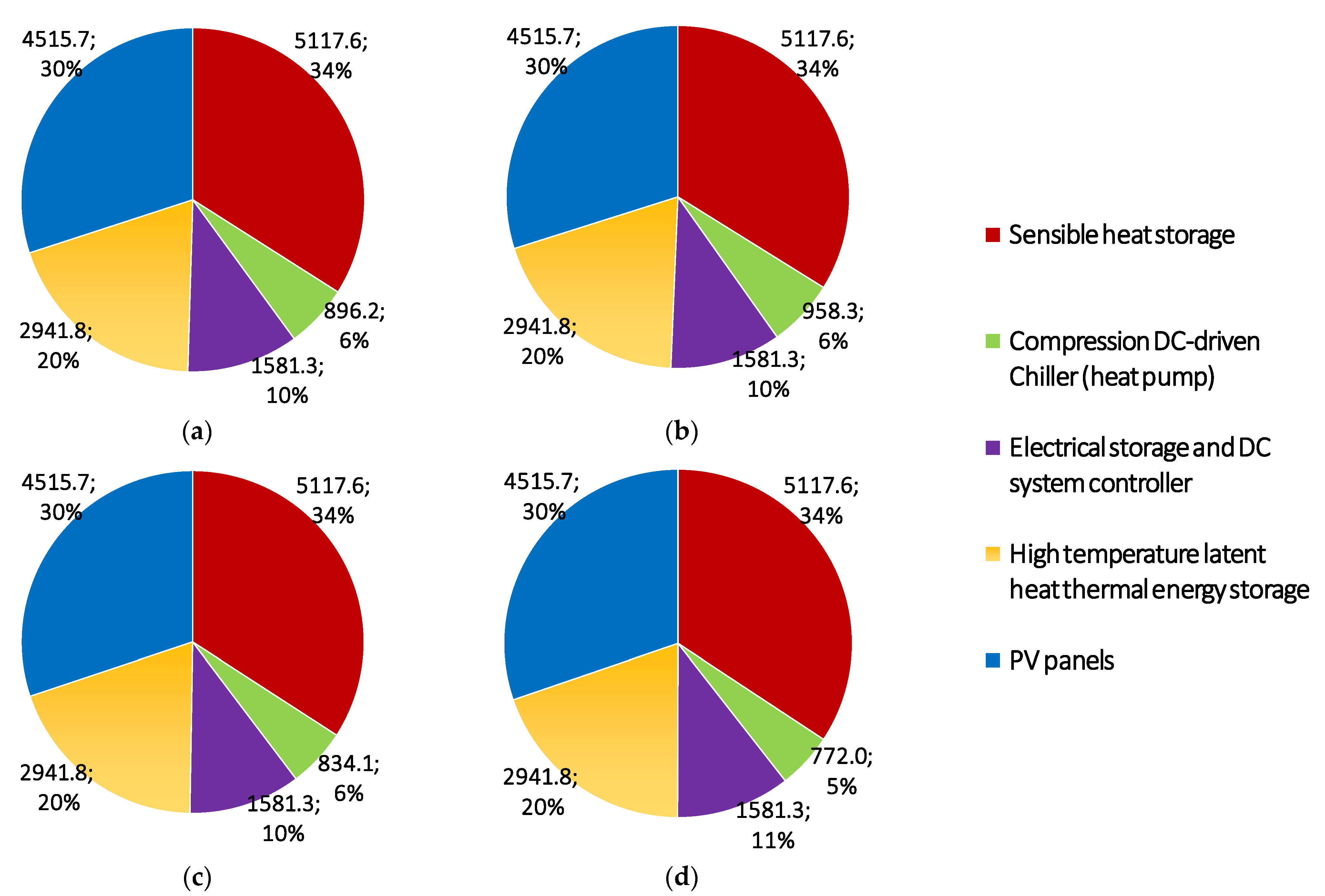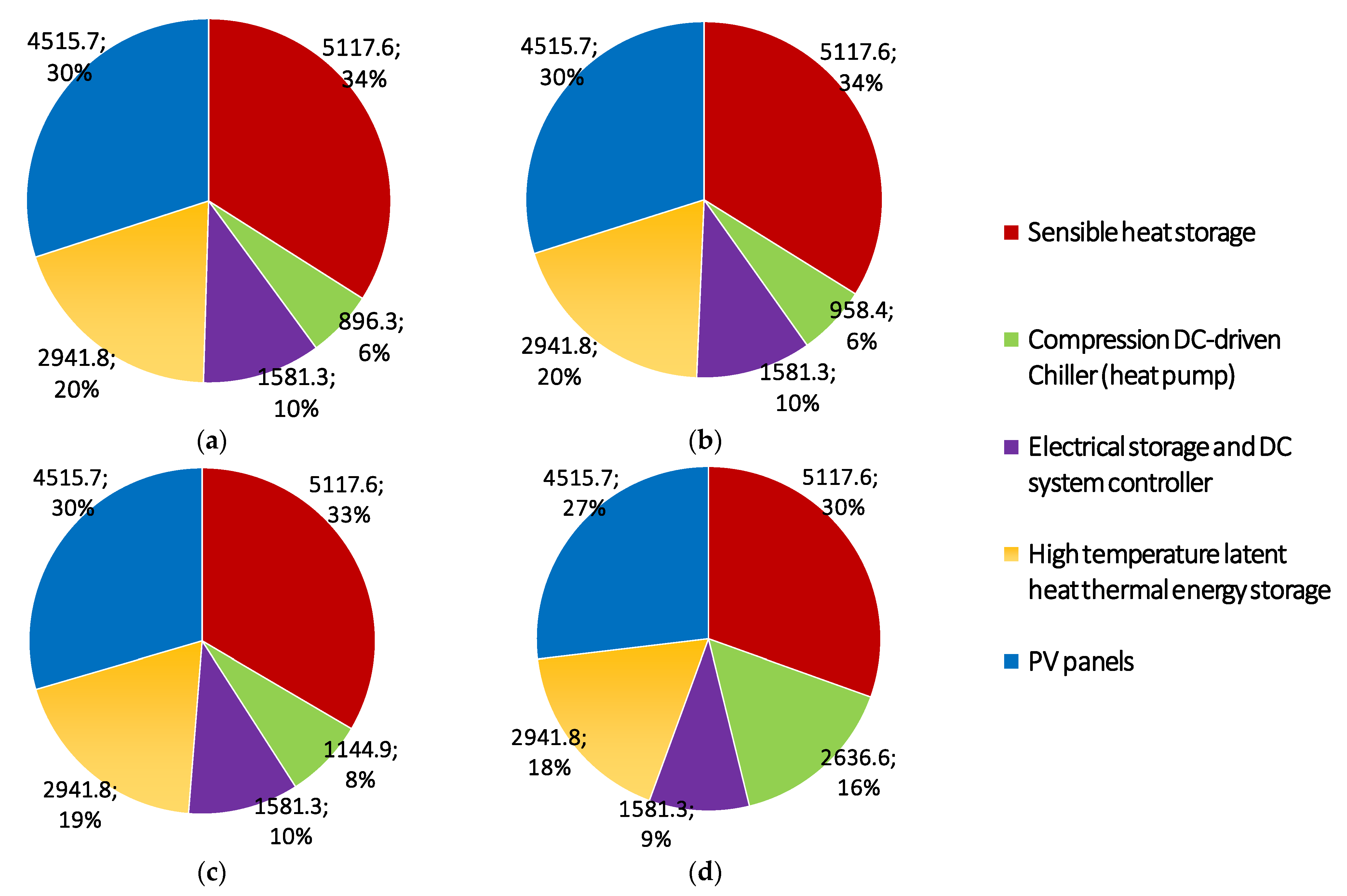1. Introduction
The European Green Deal [
1] includes new ambitious targets in Europe related to greenhouse gas (GHG) emissions to move towards a climate-neutral economy and to achieve the commitments under the Paris Agreement [
2]. These key targets for 2030 include cuts of at least 40% GHG emissions compared to that of 1990 levels to achieve at least 32% share for renewable energy and to improve the energy efficiency at least by 32.5%. With these targets, Europe aims at becoming the first climate-neutral continent.
Key actions highlighted within this new strategy are the decarbonization of the energy sector, which clearly needs more renewable energy use and more energy storage implementation and to ensure that buildings are more energy efficient [
3]. This can be obtained by merging green and smart technologies into a green smart building (GSB), as suggested and discussed in detail by Pramanik et al. [
4]. However, a building automation control system is needed, especially in complex systems, such as the one reported by Liberati et al. [
5]. In that study, an economic model predictive control approach was used to handle the problem of managing both electric and heating resources in a smart building to achieve nearly zero energy consumption and automated participation to demand response programs. An intelligent supervisory predictive control (ISPC) was proposed by Gonçalves et al. [
6] to minimize energy consumption without sacrificing the thermal comfort of building occupants. The proposed methodology proved to be capable of assisting supervisory predictive control in commercial buildings for real-time applications. A comprehensive review of the importance of sensors in the built environment and their influence on energy saving, thermal and visual comfort, as well as indoor air quality was reported by Dong et al. [
7].
With these targets in mind, a new concept was developed, where heating and domestic hot water (DHW) for buildings are produced with a high share of renewable energy (solar photovoltaic (PV)) and integration of both thermal and electrical storage [
8]. Moreover, the concept is based on the use of a heat pump with a refrigerant that has low global warming potential (GWP) and is connected to the PV panels with direct current (DC). This approach is also a contribution towards the development of net-zero energy buildings (NZEB) [
9].
Heat pumps have been integrated with energy storage for different purposes. For example, Meng et al. [
10] showed that integrating thermal energy storage (TES) with an air source heat pump can reduce the number of on–off operations. Meng et al. [
11] evaluated the heating energy and economic viability of an air source heat pump with latent TES for heating. Chwieduk and Chwieduk [
12] analyzed the use of a PV system driving a heat pump with water storage and with batteries storage.
According to the literature, the choice of refrigerant plays a key role in vapor compression heat pumps since not only is the performance affected by this selection but also the environmental impact [
13,
14]. Refrigerants to be used should have low GWP and ozone depletion potential (ODP); GWP should be lower than 150 (EU Regulation 517/2014). Refrigerants complying with these requirements are natural refrigerants, hydrocarbons (HCs), low-GWP hydrofluorocarbons (HFCs), novel hydrofluoroolefins (HFOs), and hydrochlorofluorolefins (HCFOs) [
15].
In this paper, an innovative system to produce heating and domestic hot water for heating demand-dominated climates is assessed from an environmental point of view. This system includes sensible, latent, and electrical storage to increase the use of renewable energy decreasing the use of fossil fuels, both as final energy in heating production in the building and as primary energy in the production of electricity for the grid. Moreover, this system integrates a three-media refrigerant/phase change material (PCM)/water heat exchanger in a heat pump using a low GWP refrigerant, R32. The performance of such a heat exchanger was demonstrated to be highly efficient [
16]. Moreover, the economic performance of the full system has also been assessed [
8]. The systems showed a payback time of 12.4 year with energy savings of 622 kWh
el per year. That analysis also showed that this system is best suited for low-energy buildings in cold climates.
A step forward is the analysis of the environmental performance of this innovative system. Therefore, in this paper, LCA is used to evaluate the environmental impact of the system and to assess the contribution of the refrigerant used in the overall impact, considering the huge efforts by the industry to develop refrigerants with low GWP and to develop heat pumps to use those refrigerants.
2. Methods
2.1. Case Study
The selected building was assumed to be located in Stuttgart, in the German state of Baden-Württemberg, in the southwest side of the country where a reference building was defined for a continental climate where the studied system would be implemented. Moreover, a reference system was defined to compare the environmental and energetic performance with regard to the innovative system.
As a reference building, a refurbished multi-family house (MFH) was considered as the most representative building typology for the building stock in continental climate regions. The building has a total of five floors, with two dwellings per floor and an individual staircase located inside the building envelope. Each dwelling has a living surface area of 50 m2, inhabited by three people. The ceiling/floor heights considered were 2.5 m/3.0 m, while the building width/depth was 16.3 m/7.6 m. A flat concrete roof and a glazing ratio of 20% in the north and south facades were assumed according to the most common MFH. The building model includes two zones per dwelling (1–2 and 3–4), plus the staircase zone.
The reference system consists of an air–water heat pump that can provide heat to a DHW storage tank by means of a heat exchanger located inside the storage tank, and also to the heating system of each dwelling, as shown in
Figure 1. An electric heater inside the DHW tank was considered as a back-up for DHW production. The sizing of the main system components was carried out considering heating and DHW demand of the building (
Table 1).
The diagram of the general layout of the innovative system is shown in
Figure 2. The main components of the system are a PV system connected to the heat pump, 10 sensible heat storage DHW storage tanks (one for each dwelling), a high-temperature latent heat storage tank, and an electric battery. The latent heat storage is connected at the compressor outlet to store part of the energy contained in the hot refrigerant gas that leaves the compressor, which is used to generate DHW in an efficient way. There are many innovative aspects in the proposed system, such as the direct integration of an innovative three-media refrigerant/PCM/water heat exchanger (RPW-HEX) in the hot superheated section of the heat pump, the use of electric storage combined with both sensible and latent heat storage, and the use of a DC microgrid and innovative control for coupling the electric grid with the thermal distribution. Therefore, the use of PV panels and both the thermal and electrical storage systems help increasing the share of renewable energy. A description of system operating modes can be found in [
8].
The sizing of the main system components was performed as follows: the sensible heat storage capacity was fixed according to indications from technology provider, the heat pump size was fixed to ensure the coverage of building space heating peak demand obtained from the dynamic simulations described in the following section (16 kW at the yearly minimum external temperature, −12 °C), and the latent heat thermal energy storage size was fixed to maximize its contribution to DHW production. The PV system nominal power and the electrical storage capacity were designed through an iterative process and to ensure that the yearly self-consumption and self-sufficiency KPIs (key performance indicators), obtained from the dynamic simulations explained in the following section, are both greater than 40%. As a result, the sizing that the main system components should have is shown in
Table 2.
2.2. System Simulations
Dynamic simulations were performed in TRNSYS [
17] to obtain the energy consumption of the reference building described in the previous section. The energy consumption of the innovative system to guarantee comfort inside the building, needed for the operational stage of the LCA, was obtained simulating each system component using standard and specifically developed TRNSYS types along with performance maps provided by the manufacturer of the component. Instead, the energy consumption of the heat pump of the reference system was estimated from the energy demand profile of the building, and assuming constant seasonal coefficient of performance for space heating (2.8) and space cooling (3.8) and for DHW production (3.0 in winter and 3.7 in summer). Climate data of the selected location (Stuttgart) were taken from the Meteonorm database [
18] to estimate the energy consumption for heating, cooling, and DHW supply.
The components of the innovative system can be divided in the following sub-systems:
A full one-year time frame was considered for all the TRNSYS simulations using a timestep of 1 min. The use of a relative short timestep for an annual simulation was necessary given the complexity of the system in terms of number of components and possible operational modes.
2.3. LCA Methodology
Life cycle assessment (LCA) is a methodology that is used to evaluate the environmental impact of a product over its entire life cycle. This LCA study considers a system through its life cycle from cradle to grave. The life cycle of a product system includes the manufacturing phase (extraction of raw materials, handling, and processing), operational phase (the normal and intended use of the product), and the disposal phase (the end of the product until landfill disposal) [
19].
In common, the major focus of utilizing LCA methodology is on reducing the environmental impact of specific products under consideration for more sustainable solutions through decision-making process [
20]. A full LCA requires significant effort and expertise, although according to UNE-EN ISO 14040:2006 standard [
21], performing an LCA should at least be performed through four main interrelated steps. Those steps are definition of the goal and scope, developing the life cycle inventory (LCI), carrying out the life cycle impact assessment (LCIA), to finally interpreting the results.
The LCA of this study is based on the impact assessment method ReCiPe and global warming potential (GWP), extracted from the database Ecoinvent [
22]. ReCiPe indicator was indicated by the Joint Research Commission of European Union [
23] as the best method for the European context in comparison with EPS2000, Eco-indicator 99, and IMPACT2002+. The ReCiPe indicator, a method used to assess the environmental impact, is based on an update version of CML and Eco-indicator 99 [
19]. The primary objective of the ReCiPe method is to transform the long list of life cycle inventory results into a limited number of indicator scores. These indicator scores express the relative severity on an environmental impact category. In ReCiPe indicators are determined at two levels, eighteen midpoint indicators, and three endpoint indicators. Midpoint indicators focus on single environmental interventions at the level of a cause–effect chain between emissions and the endpoint level. Endpoint indicators show the environmental impact on three higher damage levels: effect on human health, biodiversity, and resource scarcity [
24]. Converting midpoints to endpoints simplifies the interpretation of the LCA results (
Figure 3).
The IPCC GWP indicator is used for characterization at midpoint level, and only this indicator was selected as representative for all midpoint model currently used in LCA studies according to the Joint Research Commission of European [
26]. The IPCC GWP is an indicator based on the ratio of the radiative damage force of the greenhouse gases. In order to measure GWP, the gas must have a long atmospheric lifetime, which means that the gas lasts long enough in the atmosphere to mix and spread through it. This given time used by GWP depends on if it is desired to predict the emissions long-term effects (GWP 100a) or their short-term effects (GWP 20a), where the values of the GWP are measured in kgCO2-eq [
27].
The assessment of each impact category according to each indicator is given in Equation (1):
where
is the
j impact category,
is the coefficient of damage (extracted from database Ecoinvent) associated with the component
k and impact
j and, finally, the
is the life cycle inventory LCI entry (i.e., kg of paraffin) [
28].
2.3.1. Definition of Goal and Scope
The goal of the LCA activities carried out in this paper is related to the materials and components. Benchmarking against conventional products was intended and achieved by the use of equivalent reference systems that should provide similar functionalities to the building. It is then one of the main goals of the LCA study to identify the components with higher environmental impact.
The study was focused on the system and not on the building, meaning only the relevant components of the system were included in the LCA study. Therefore, the following parts (modules) of the innovative system were included: high-temperature latent heat thermal energy storage (RPW-HEX), electrical storage and DC bus, compression DC-driven chiller (heat pump), sensible heat storage (decentralized tank), and PV system.
2.3.2. Functional Unit
The scope of this study was defined according to the performance characteristics of the system under study. The functional unit must be consistent with the objectives and scope of the system (according to UNE EN ISO 14040 and 14044) [
21,
29] since it determines the reference flow from which the inputs and outputs of the system are determined. The results of the LCA will be expressed on the basis of the functional unit. In this study, the functional unit of a 1 m
2 of livable floor per year was adopted, based on publications of LCA studies in the construction sector [
19,
20]. A 30-year system lifespan is assumed for this study. Depending on the lifespan of the different components, the number of replacements of every component or product along the 30-year period was also calculated, which is a crucial point to be considered in the manufacturing phase.
2.3.3. System Boundaries
The study accounts for the raw material extraction to final disposal of the portion of the life cycle and considers embodied environmental impacts. The system boundaries determine which unit processes are included in the LCA study. This model encompasses three distinct phases of evaluation where each product during its lifetime goes through different stages, and there are a number of operations in each phase:
Manufacturing stage—materials production phase, including extraction of raw materials, transportation to the factory, and manufacturing processes.
Operational stage—all activities related to the use of the systems, including all operating energy for heating, cooling, and domestic hot water (DHW).
End-of-life stage—the dismantling and demolishing of the system components and their transport to the landfill site and/or to recycling sorting plants.
2.3.4. Inventory Analysis of the Manufacturing Stage
The life cycle inventory analysis (LCIA) is defined as a phase of the LCA involving the compilation of inputs and outputs for a given product system throughout its life cycle [
30]. The LCI data were extracted from a recompilation of data with the help of different partners of the project. The inventory list of all the materials used for the manufacturing phase of the system that spans this study is shown in
Table 3 and
Table 4 for the reference system and the innovative system, respectively. All data were provided by the producers of the equipment. The tables list the elements to be considered, their amount in the system (named “unit” in the table), as well as their quantification (in units or kg); the replacement is the number of times that given unit has to be replaced during the time life of the whole system, which provides the total amount.
2.3.5. Inventory Analysis of the Operational Stage
The annual energy consumption of both systems was obtained through simulations, as explained in
Section 2.2, using a set-point temperature of 25 °C in summer and 20 °C in winter, and is shown in
Table 5 for the reference system and in
Table 6 for the innovative system.
Comparing the total annual energy consumption of the innovative system with that of the reference system, it can be clearly seen that the innovative solution achieves significant reduction in the electricity consumption, from 15,292 to 10,973 kWh per year, which represents a reduction of almost 30%.
2.3.6. LCIA of Manufacturing and Disposal Stage
The LCIA for the manufacturing and disposal stage of the reference and the innovative systems are shown in
Table 7 and
Table 8, respectively.
2.3.7. LCIA of the Operational Stage
The LCIA of the operation stage are presented in
Table 9 for the reference and in
Table 10 for the innovative one.
4. Conclusions
A detailed LCA was carried out of an innovative system for heating and domestic hot water production, including sensible, latent, and electric storage. The LCA was performed comparing the results to a selected reference system. The LCA was carried out for a functional units m
2 of living floor area, and using two different indicators, ReCiPe and IPCC GWP (20 years and 100 years). The operational data were given by simulations as explained in
Section 2.2.
Results show that when using the ReCiPe indicator, the overall impact of the innovative system is lower than that of the reference system. In all damage categories, the impact of the innovative system is lower than that of the reference system. Again, the impact of the manufacturing and disposal stage is higher than for the operational stage, but this difference is compensated with the one of the operational stage (lower in the innovative system).
On the other hand, when using the IPCC GWP indicator, the impact of the innovative system is lower than that of the reference system. The impact of the operation stage clearly makes the difference, since although in the manufacturing stage, the impact of the innovative system is very similar than that of the reference system, the decrease in the operational stage in the innovative clearly compensates for it.
If the contribution of the different subsystems is analyzed, it can be seen that the sensible heat storage and the PV panels are the subsystems with higher impact (both with a contribution of 34% and 30%, respectively), while the high-temperature latent TES storage sub-system has a contribution of 20%. The other two sub-systems considered, the electrical storage and the compression heat pump, have a contribution of 10% and 6%, respectively.
Finally, the parametric study carried out analyzed the influence of the impact of the refrigerant. The analysis was conducted taking R134a as baseline, since this is the refrigerant found in the used database Ecoinvent. The analysis performed on changing both the impact of the refrigerant or the amount of refrigerant shows that the contribution of the refrigerant to the overall impact of the studied system does not vary enough to consider that decreasing the impact of the refrigerant will contribute to decreasing the overall impact of the innovative system.
